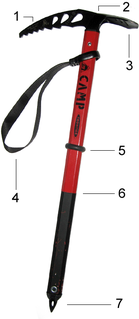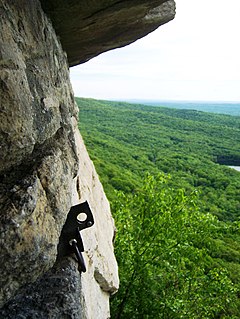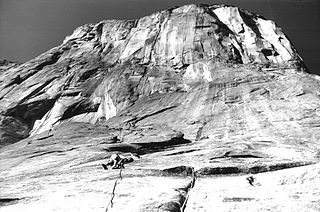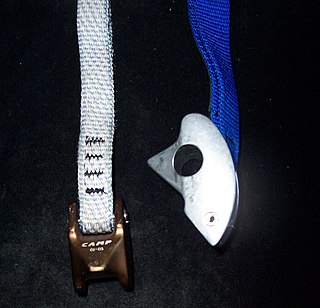
Climbing is the activity of using one's hands, feet, or any other part of the body to ascend a steep topographical object. It is done for locomotion, recreation and competition, and within trades that rely on ascension; such as emergency rescue and military operations. It is done indoors and out, on natural and man-made structures.
Climbing protection is any of a variety of devices employed to reduce risk and protect others while climbing rock and ice. It includes such items as nylon webbing and metal nuts, cams, bolts, and pitons.

A spring-loaded camming device is a piece of rock climbing or mountaineering protection equipment. It consists of two, three, or four cams mounted on a common axle or two adjacent axles, so that pulling on the axle forces the cams to spread farther apart. This is then attached to a sling and carabiner at the end of the stem. The SLCD is used by pulling on the "trigger" so the cams retract together, then inserting it into a crack or pocket in the rock and releasing the trigger to allow the cams to expand. A pull on the rope, such as that generated by a climber falling, will cause a properly placed SLCD to convert the pulling force along the stem of the unit into outwards pressure on the rock, generating massive amounts of friction and preventing the removal of the unit from the rock. Because of the large forces which are exerted on the rock when an SLCD is fallen on, it is very important that SLCDs are only placed in solid, strong rock.

Traditionalclimbing, is a style of rock climbing in which a climber or group of climbers place all gear required to protect against falls, and remove it when a pitch is complete. Traditional bolted face climbing means the bolts were placed on lead and/or with hand drills. The bolts tend to be much farther apart than sport climbs. For example, a trad bolted route may have bolts from 15–75 feet apart. A sport route may have bolts from 3–10 feet apart, similar to a rock climbing gym. The term seems to have been coined by Tom Higgins in the piece "Tricksters and Traditionalists" in 1984. A trad climber is called a traditionalist.

An ice axe is a multi-purpose hiking and climbing tool used by mountaineers in both the ascent and descent of routes that involve frozen conditions with snow or ice. An ice axe can be held and employed in a number of different ways, depending on the terrain encountered. In its simplest role, the ice axe is used like a walking stick in the uphill hand, the mountaineer holding the head in the center. It can also be buried pick down, the rope tied around the shaft to form a secure anchor on which to bring up a second climber, or buried vertically to form a stomp belay. The adze is used to cut footsteps, as well as scoop/bucket seats in the hillside and trenches to bury an ice axe belay. The long-handled alpenstock was a predecessor to the modern ice axe.

This glossary of climbing terms is a list of definitions of terms and jargon related to rock climbing and mountaineering. The specific terms used can vary considerably between different English-speaking countries; many of the phrases described here are particular to the United States and the United Kingdom.

A wide range of equipment is used during rock or any other type of climbing that includes equipment commonly used to protect a climber against the consequences of a fall.

Black Diamond Equipment is a manufacturer of equipment for climbing, skiing, and mountain sports, based in Utah, United States. The company also has a global office in Innsbruck, Austria. The company is owned by Clarus Corporation, which also owns Pieps, ClimbOn! Skincare, and Sierra Bullets.

Aid climbing is a style of climbing in which standing on or pulling oneself up via devices attached to fixed or placed protection is used to make upward progress.

In rock climbing, a nut is a metal wedge threaded on a wire and is used for protection by wedging it into a crack in the rock. Quickdraws are clipped to the nut wire by the ascending climber and the rope threads through the quickdraw. Nuts come in a variety of sizes and styles, and several different brands are made by competing manufacturers. Most nuts are made of aluminum. Larger nuts may be threaded on Dyneema cord instead of wire, but this has become unusual.

Clean climbing is rock climbing techniques and equipment which climbers use in order to avoid damage to the rock. These techniques date at least in part from the 1920s and earlier in England, but the term itself may have emerged in about 1970 during the widespread and rapid adoption in the United States and Canada of nuts, and the very similar but often larger hexes, in preference to pitons, which damage rock and are more difficult and time-consuming to install. Pitons were thus eliminated in North America as a primary means of climbing protection in a period of less than three years.

In climbing, a piton is a metal spike that is driven into a crack or seam in the climbing surface with a climbing hammer, and which acts as an anchor to either protect the climber against the consequences of a fall or to assist progress in aid climbing. Pitons are equipped with an eye hole or a ring to which a carabiner is attached; the carabiner can then be directly or indirectly attached to a climbing rope.

Rock climbing is a sport in which participants climb up, down or across natural rock formations or artificial rock walls. The goal is to reach the summit of a formation or the endpoint of a usually pre-defined route without falling. Rock climbing is a physically and mentally demanding sport, one that often tests a climber's strength, endurance, agility and balance along with mental control. Knowledge of proper climbing techniques and the use of specialized climbing equipment is crucial for the safe completion of routes.

Yvon Chouinard is an American rock climber, environmentalist, and outdoor industry billionaire businessman. His company, Patagonia, is known for its environmental focus.
The American Death Triangle, also known as the "American Triangle", "Death Triangle" or "Triangle Anchor" is a type of rock and ice climbing anchor infamous for both magnifying load forces on fixed anchors and lack of redundancy in attachment to the anchor. This anchor is based on the "Stone Dog Hitch".

A Tricam is a type of climbing protection equipment. A versatile nut/cam hybrid, the Tricam was invented by Greg Lowe in 1973, and came to market in 1981. They are currently manufactured by C.A.M.P. of Premana Italy.

Tom Frost was an American rock climber known for big wall climbing first ascents in Yosemite Valley. He was also a photographer and climbing equipment manufacturer. Frost was born in Hollywood, California and died in Oakdale, California.

Camalot is a brand of spring-loaded camming devices manufactured by Black Diamond Equipment used to secure ropes while rock climbing.

Crack climbing is a type of rock climbing in which the climber follows a crack in the rock and uses specialized climbing techniques. The sizes of cracks vary from those that are just barely wide enough for the fingers to fit inside, to those that are so wide that the entire body can fit inside with all limbs outstretched. Many traditional climbing routes follow crack systems, as they provide natural opportunities for placing protective equipment.

















